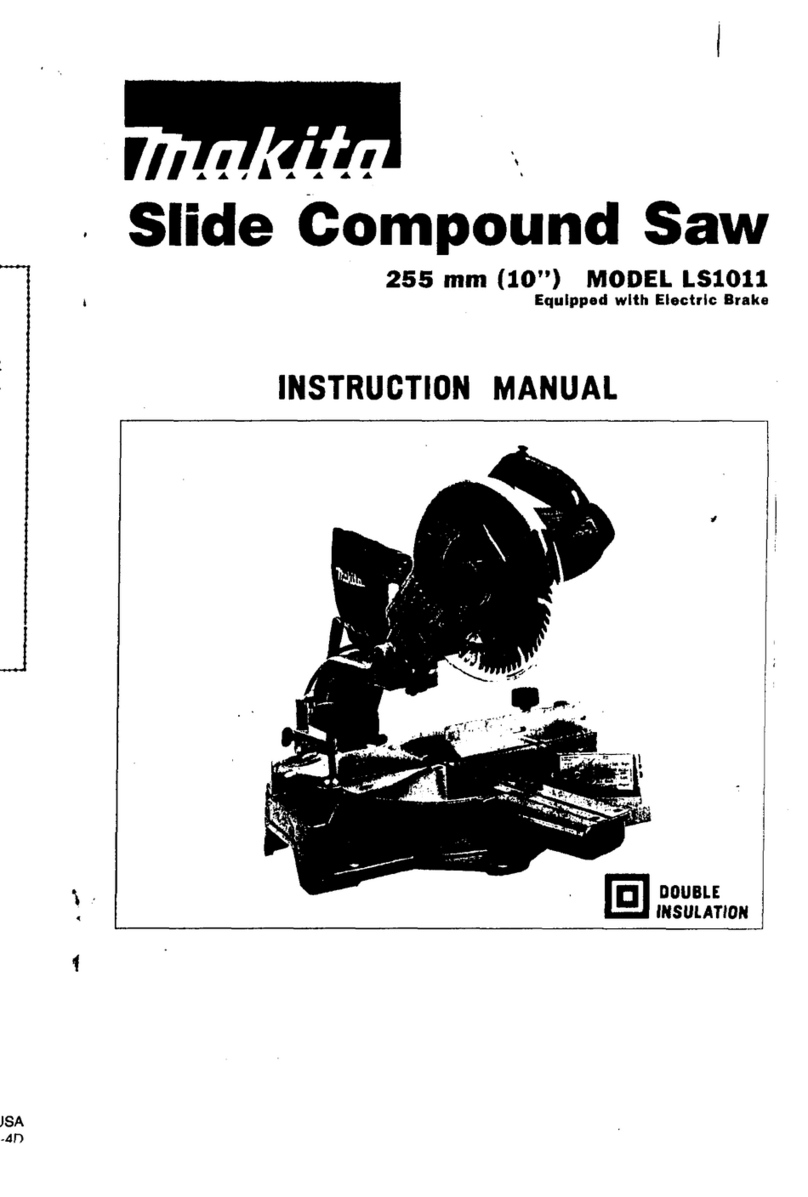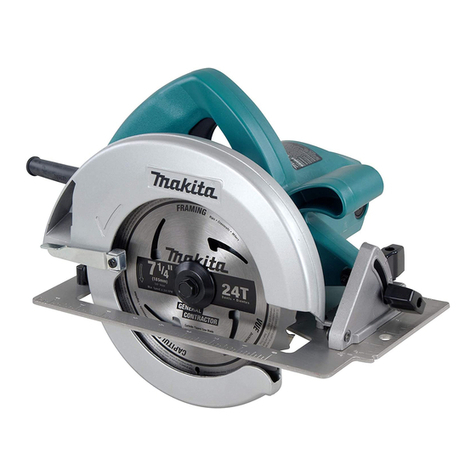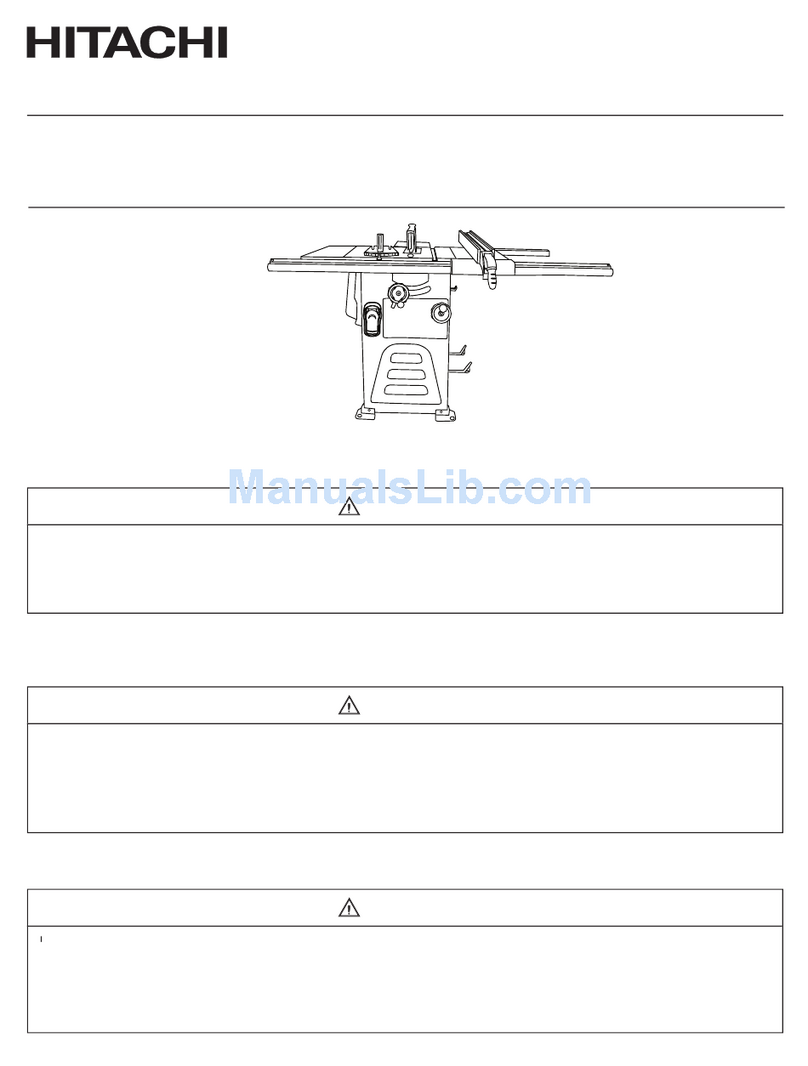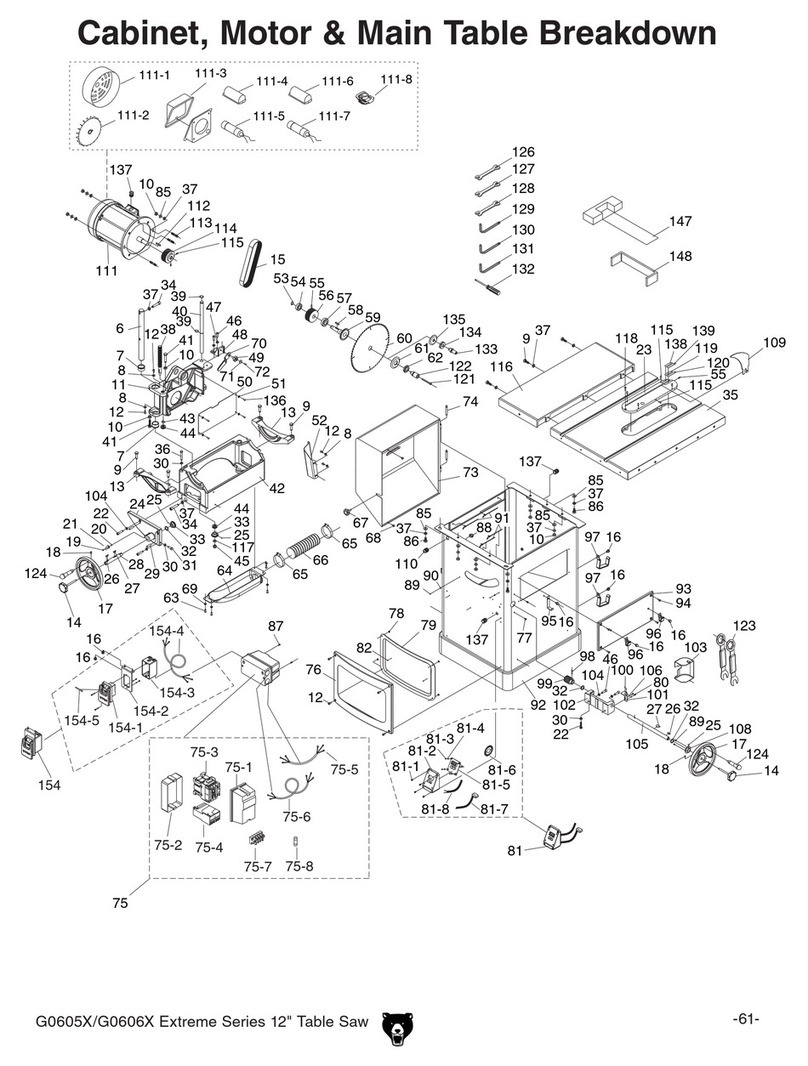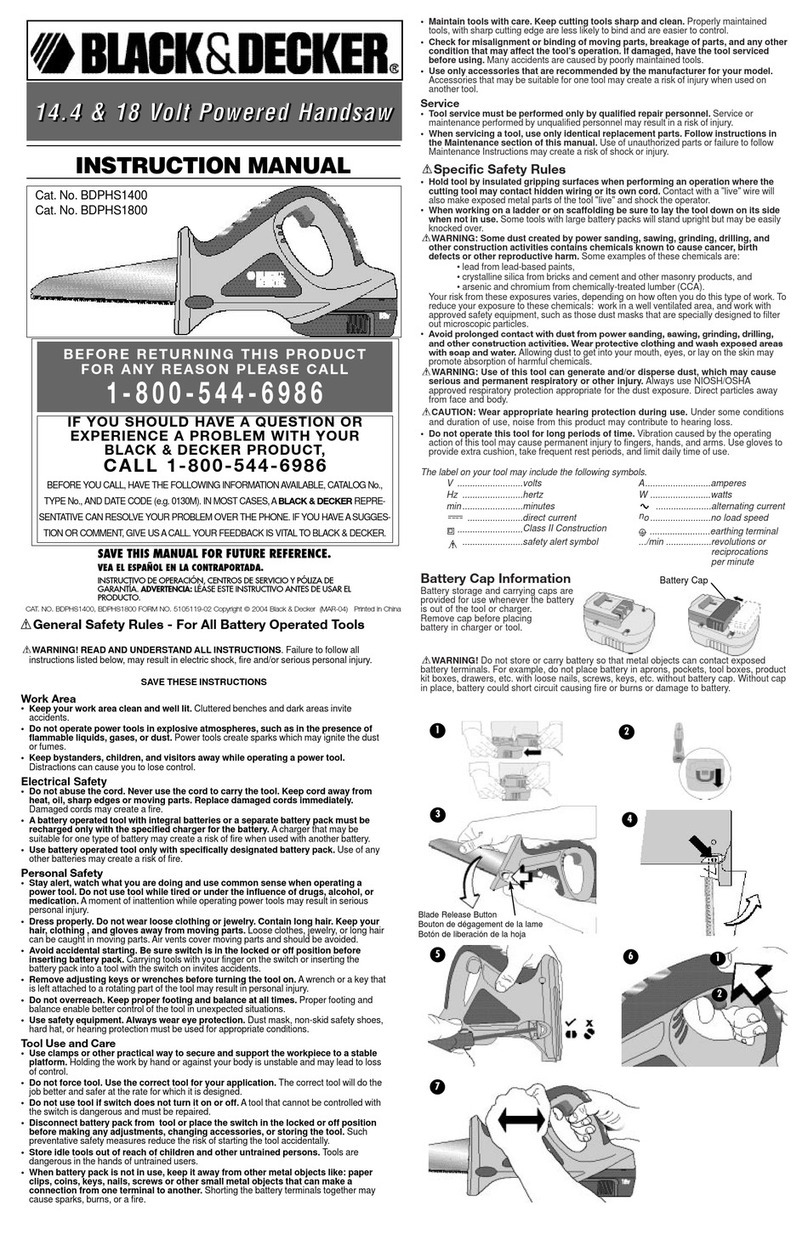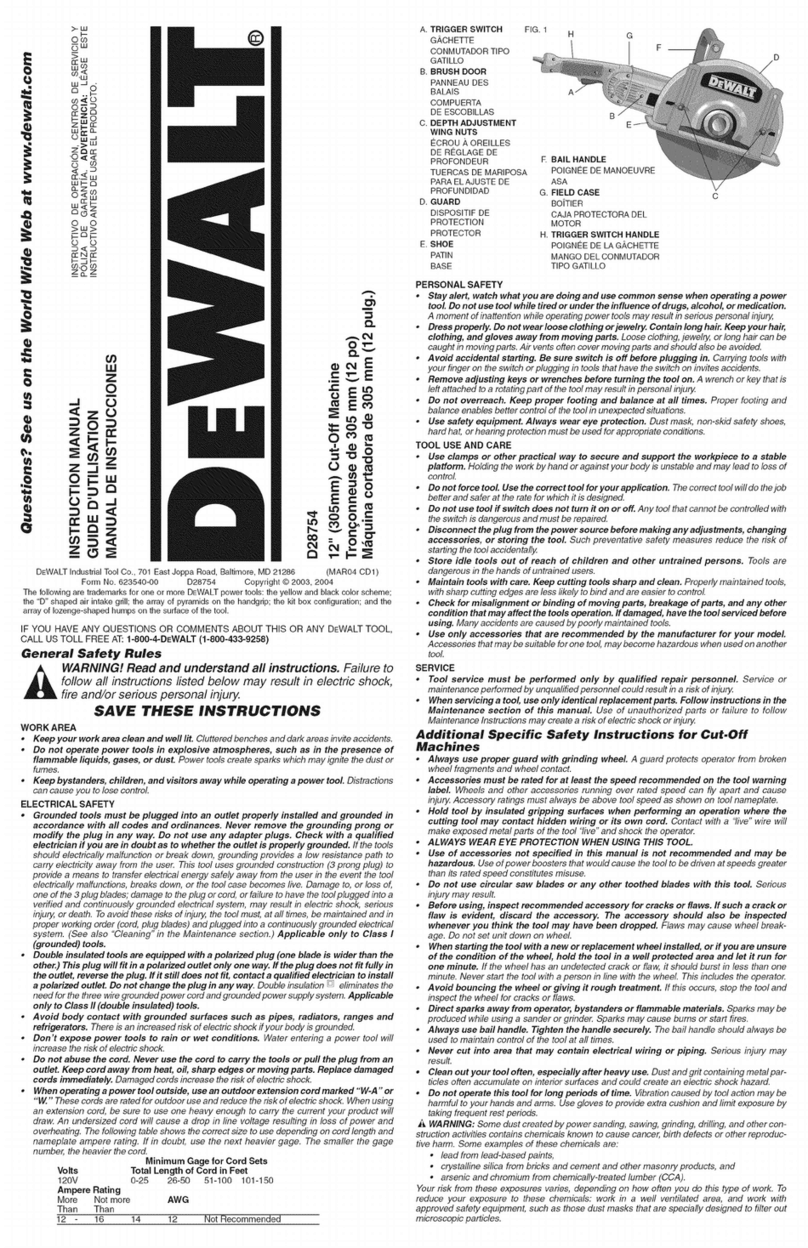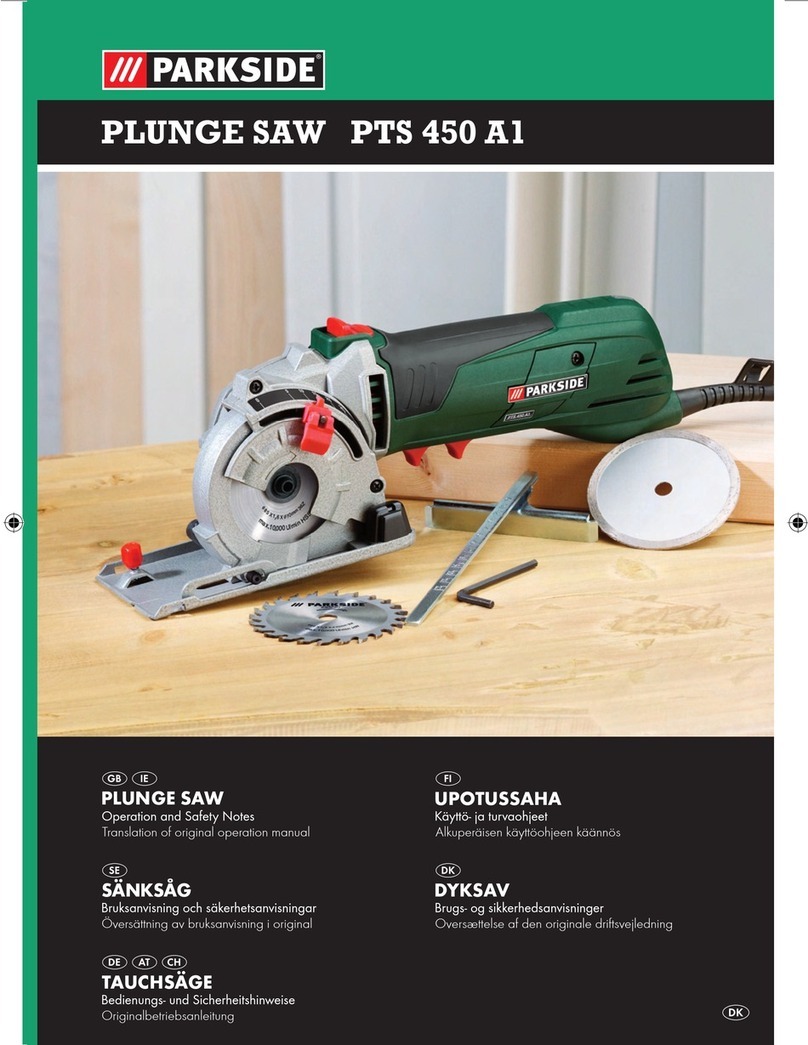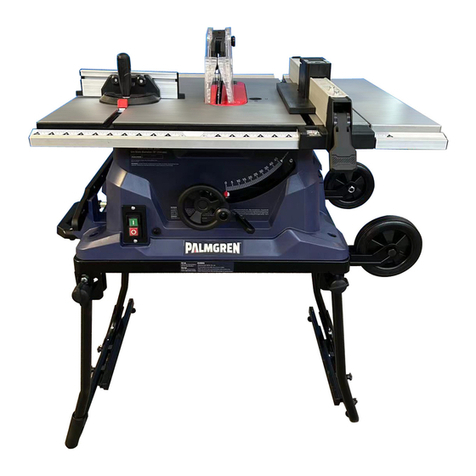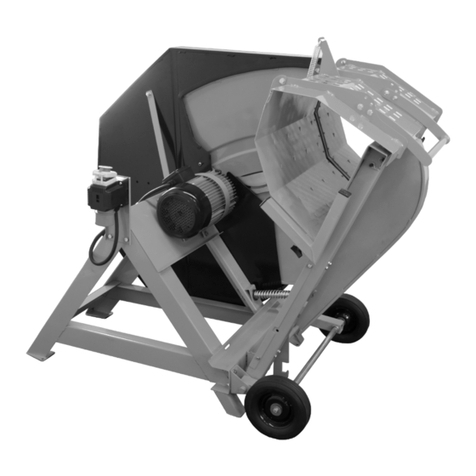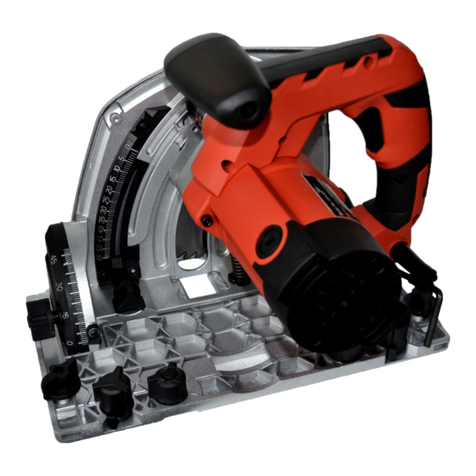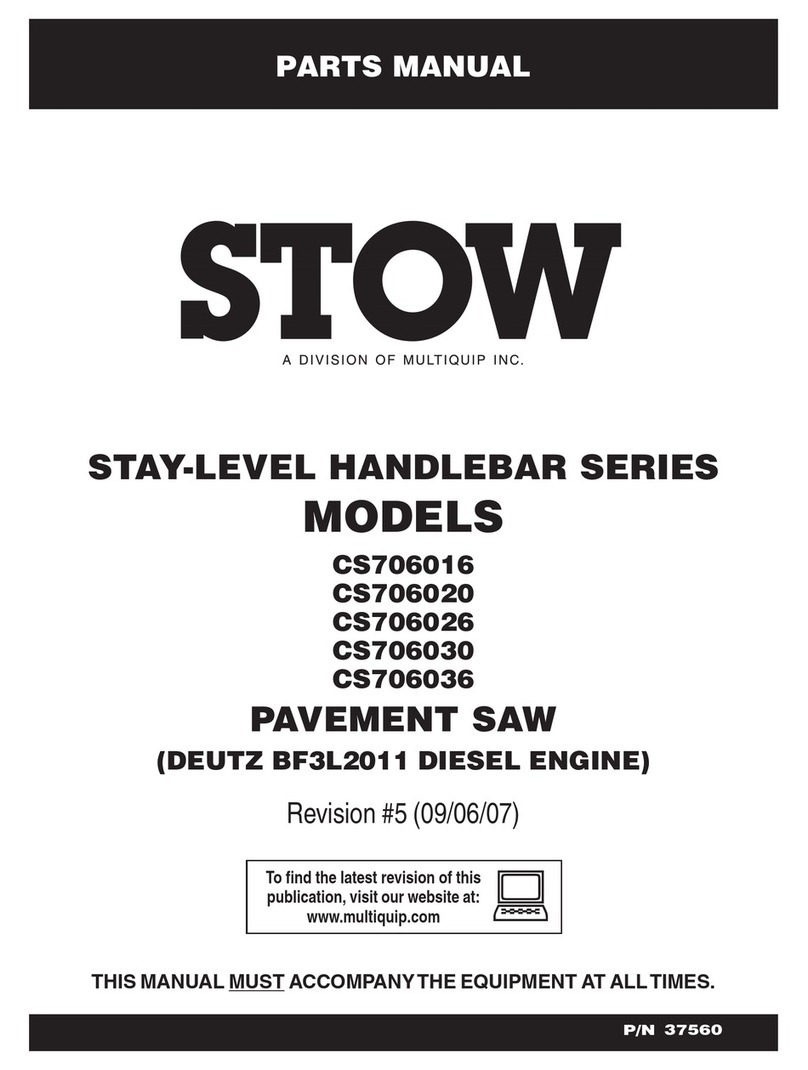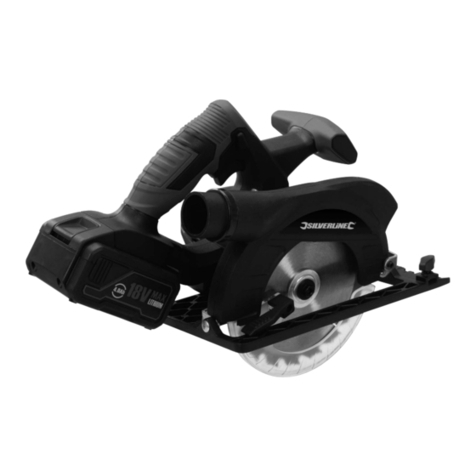Makita LS1000 User manual

Mitea
SKW
Blade
d,amefe,
255
mm
(10")
MODEL
LSlOOO
Equipped with Electrical Blade Brake
Ne1
weigh1
Max
cuitinq
capacifies
IH
x
WI
Dirneriiion~
IL
x
W
x
HI
Hole
diamerer
Cross cut
I0"I
1
Miter
cut
145"l
INSTRUCTION MANUAL
DOUBLE
INSULA1'ION
SPEC
I
F
I
CAT
I
0
N
S
255
mm
1
15 88
mm
and
25
mm
I
70
mm
x
122
mm
70
mm
x
90
mm
4.100
496
mm
x
470
mm
x
442 mm 18
0
kg
12
3/4"
x
4 3)4
I
I
12
3,4"
x
3 112")
I
Rlmin
1
119
112"
x
18 1
2"
x
17
3r8"I
I
140lbsl
1lO"l
15,8"
and
31
32
I
*
Manufacturer reserves the right to change specifications without notice.
*
Note: Specifications may differ from country to country.

BEFORE CONNECTING YOUR TOOL
TO
A POWER SOURCE
Be sure you have read all
GENERAL POWER TOOL SAFETY RULES
GENERAL SAFETY PRECAUTIONS
(For
All
Tools)
1.
KNOW YOUR POWER TOOL. Read the owner's manual carefully. Learnthe
tools applications and limitations, as well as the specific potential hazards
peculiar to
it.
2.
KEEP GUARDS IN PLACE and in working order.
3.
REMOVE ADJUSTING KEYS AND WRENCHES. Form habit of checking to
see that keysand adjusting wrenches are removed from tool before turning
it
on.
4.
KEEP WORK AREA CLEAN. Cluttered areas and benches invite accidents.
5.
DON'T USE INDANGEROUS ENVIRONMENT. Don't use power tools indamp
or wet locations, or expose them to rain. Keep work area well lighted.
6.
KEEP CHILDRENAWAY. All visitors should be kept safe distance from work
area.
7.
MAKE WORKSHOP KID PROOF with padlocks, master switches, or by
removing starter keys.
8.
DON'T FORCETOOL.
It
will do thejob better and safer at the rate for which
it
was designed.
9.
USE RIGHT TOOL. Don't force tool or attachment to do a job for which
it
was not designed.
IO.
WEAR PROPER APPAREL. Wear no loose clothing, gloves, neckties, rings,
bracelets, or other jewelry which may get caught
in
moving parts. Nonslip
footwear is recommended. Wear protectivehair coveringtocontain longhair.
11.
ALWAYS USE SAFETY GLASSES. Also useface or dust mask if cutting oper-
ation is dusty. Everyday eyeglassesonly have impact resistant lenses, they
are NOT safety glasses.
12.
SECURE WORK. Use clamps or avise to hold work when practical. It's safer
than using your hand and
it
frees both hands to operate tool.
13.
DON'T OVERREACH. Keep proper footing and balance at all times.
14.
MAINTAIN TOOLS WITH CARE. Keep tools sharp and clean for best and
safest performance. Follow instructions for lubricating and changing acces-
sories.
15.
DISCONNECTTOOLS before servicing; when changing accessories such as
blades, bits, cutters, and the like.
2

16.
REDUCE THE RISK OF UNINTENTIONAL STARTING. Make sure switch is
in off position before plugging in.
17.
USE RECOMMENDED ACCESSORIES. Consult the owner's manual for
recommendedaccessories. The useof improper accessories may cause risk
of injury to persons.
18.
NEVER STAND ON TOOL. Serious injury couldoccur if the tool istipped or
if the cutting tool is accidentally contacted.
19.
CHECK DAMAGED PARTS. Before further use of the tool, a guard or other
part that is damaged should be carefully checked to determine that
it
will
operate properly and perform its intended function
-
check for alignment
of movingparts, binding of movingparts, breakage of parts, mounting, and
any other conditions that may affect itsoperation. A guard or other part that
is damaged should be properly repaired or replaced.
20.
DIRECTION
OF
FEED. Feed work intoa blade or cutter against the direction
of rotation of the blade or cutter only.
21.
NEVER LEAVE TOOL RUNNING UNATTENDED. TURN POWER OFF. Don't
leave
tool
until
it
comes to a complete stop.
22.
This tool is intend
d
for residential use only.
23.
When servicing use only identical replacement parts.
9
VOLTAGE WARNING: Before connectingthe tool toa power source (receptacle,
outlet, etc.) be sure the voltage supplied is the same as that specified on the
nameplate of the tool. A power source
with
voltage greater than that specified
for the tool can result
in
SERIOUS INJURY tothe user
-
as well as damage to
the tool. If
in
doubt,
DO
NOT PLUG IN THE TOOL. Using a power source
with
voltage less than the nameplate rating is harmful to the motor.
3

ADDITIONAL SAFETY RULES
1.
Don't use the tool in the presence of flammable liquids or gases.
2.
Check the blade carefully for cracks or damage before operation. Replace
cracked or damaged blade immediately.
3.
Use only flanges specified for this tool.
4.
Be careful not to damage the arbor, flanges (especially the installing sur-
5.
Make sure that the turn base is properly secured
so
it
will not move during
6.
Always keep the table top clear of chips, small pieces and
so
on
in
order
7.
Avoid cutting nails. Inspect for and remove all nailsfrom the workpiece be-
8.
Make sure the shaft lock is released before the switch is turned on.
9.
Be sure that the bladedoes notcontact the turn baseinthe lowest position.
face) or bolt. Damage to these parts could result
in
blade breakage.
operation.
to maintain a safe, clean surface.
fore operation.
IO.
Hold the handle firmly.
11.
Keep hands away from rotating parts.
12.
Make sure the blade is not contacting the workpiece before the switch is
turned on.
13.
Before using the tool on an actual workpiece, let
it
run for a while. Watch
for vibration or wobbling that could indicate poor installation or a poorly
balanced blade.
14.
Wait
until
the blade attains full speed before cutting.
15.
Stop operation immediately if you notice anything abnormal.
16.
Do
not attempt to lock the trigger in the on position.
17.
Always switchoff and wait for the bladetocome toa complete stopbefore
removing, securing workpiece, changing workpiece position, angle or the
blade itself.
18.
Don't abusecord. Never yank cordtodisconnect
it
fromthe receptacle. Keep
cord away from heat, oil, water and sharp edges.
WARNING
For Your Own Safety Read Instruction
Manual Before Operating Miter Saw
1.
Wear eye protection.
2.
Keep hands out of path of saw blade.
3.
Do
not operate saw without guards
in
place.
4.
Do
not perform any operation freehand.
5.
Never reach around saw blade.
6.
Shut off power and wait for saw blade tostop before servicing or adjusting
tool.
SAVE THESE INSTRUCTIONS.
4

HOW
TO
USE
Handlelatch
This tool
is
equipped with
a
handle latch
which
is
used to lock the handle in the
lowered position. To release from the
lowered position, lower the handleslightly
and turn the handle latch to the released
position.
To
lock the handle inthe lowered
position, lower the handle fully and turn
the handle latch to the locked position.
When carrying the tool, lock the handle in
the lowered position and secure the turn
base by means of the grip.
Bench mounting miter saw
This tool should be bolted with two bolts
to
a
level
and stable surface using the bolt
holesprovided inthe tool's base.
Removing
or
installingsaw blade
First, be sure to unplug the tool from the
power source.
Loosen the screw holdingthe center cover.
Raise
the safety cover and center cover.
i
Handle
latch
Fig.
1
Fig.
2
Fig.
3
Fig.
4
5

Fig.
5
Fig.
6
CAUTION
:
*When installingthe blade, make sure that the direction of the arrow on the surface of
0
Use only the Makitasocket wrench to installor remove the blade.
the blade
is
compatible with that on the blade
case.
Safety
cover
When cutting operations are performed,
the safety cover rises
as
a
result of contact
with the workpiece. The cover returns to
its
original position when the cut
is
com-
pleted and the handle
is
raised. NEVER
DEFEAT
OR
REMOVE THE SAFETY
COVER.
In the interest of your personal
safety, always maintain the safety cover in
a
freely moving condition. Any irregular
operation of the safety cover should
be corrected immediately. NEVER USE
THE TOOL WITH A FAULTY SAFETY
COVER. If the see-through safety cover
becomes dirty, or sawdust adheres to
it
in such
a
way that the blade and/or workpiece
is
no longer easily visible; unplug the saw and clean the cover carefully with
a
damp cloth.
Do
notuse solvents or any petroleum-basedcleaners on the plastic cover.
6

Maintainingmaximum cuttingcapacity
Unplug the tool before any adjustment
is
attempted.
This tool
is
factory adjusted to provide
the max. cutting capacity for
a
255"
(1
0")
saw blade. When the diameter of the
blade has been reduced due to sharpening,
loosen the hex nut
at
the rear of the gear
housing. Use
a
screwdriver to adjust the
depth adjusting bolt. The saw blade
is
lowered by turning the depth adjusting
bolt counterclockwise and raised by turn-
ing
it
clockwise. Adjust
so
that when the
handle
is
in the
fully
lowered position,
there will be
a
distance of about 122 mm
(4-3/4")
from the front face of the guide
fence to the point where the front edge of
the blade enters the kerf. Now tighten the
hex nut with the wrench while carefully
holding the adjusting bolt in position with
the screwdriver.
Fig.
I
Fig.
9
Adjusting
for
smooth handleaction
The hex lock nut holding together the gear
housing and arm has been factory adjusted
to assure smooth handle action up and
down and to guarantee precise cutting.
Do
not tamper with
it.
Should looseness develop
at
the gear hous-
ing and arm connection, perform the fol-
lowing adjustment. Work the handle up
and down while tightening the hex lock
nut;
the
best
position to tighten the hex
lock nut
is
just before the motor body
weight
is
obvious.
Fig.
11
After adjusting the hex lock nut, be sure the handle returns automatically to the initial
position from any position. If the hex lock nut
is
too loose, the cutting accuracy will be
affected; if
it
is
too tight,
it
will be hard to work the handle up and down. Note that this
is
a
self locking nut;
it
is
a
special type that does not loose in normal use.
It
should not
be overtightenedor replaced with other types of nuts.
7

Positioningfor miter angle
Loosen the grip by turning counterclock-
wise. Press down the latch spring. This
allows the turn base to turn freely. When
you have moved the grip to the position
where the pointer indicates the desired
angle on the miter
scale,
release the latch
spring and securely tighten the grip clock-
wise.
NOTE
:
I
Latch
spring
P
Fig.
11
The latch spring automatically locates miter angles
of
0,
15,22.5,30
and
45
degrees. To
select one of these angles, turn the turn base near the desired angle while releasingthe
latch spring and allow the latch spring to
seat
itself in the miter notch. Then tighten the
grip securely.
Alignment for squareness
This tool was carefully adjusted and aligned for squareness of cut
at
the factory, but
rough handling may have affected the alignment. If your tool
is
not aligned properly,
perform the following.
Loosen the grip and
set
the turn base
at
zero degree by turning the turn base and
allowing the latch spring to
seat
itself in
the miter notch.
If the pointer on the indication plate
is
not
at
zero on the miter scale, gently tighten
the grip and then loosen the screws on the
indication plate. Adjust the indication
plate
so
that the pointer will
be
at
zero
on
the miter scale. Then tighten the screws
on the indication plate. Tighten the grip
securely and loosen the hex bolts on the
1
Fig.
12
guide fence.Square the side of the blade with the side of the guide fence using
a
ruler
(try-squareor the like).Then securely tighten the hex bolts on the guide fence.
8

Emptying
dust
bag
When the dust bag
is
about half full, re-
move the dust bag from the tool and pull
the fastener out. Empty the dust bag of
its
contents, tapping
it
lightly
so
as
to
remove
particles adhering to the insides which
might hamper collection.
I
Fig.
14
Securing workpiece
By
turning the knob on the
vise
counterclockwise,the screw
is
released and the
vise
shaft
can be moved rapidly in and out.
By
turning the knob clockwise, the screw remains
secured.
To
grip workpieces, turn the knob gently clockwise, until the projection reaches
its
topmost position, then fasten securely.
If
the knob
is
forced in or pulled out while
being turned clockwise, the projection may stop
at
an angle. In this
case,
turn the knob
back counterclockwiseuntil the screw
is
released, before turning again gently clock~se.
CAUTION
:
.Grip workpieces only when the projec-
tion
is
at
the topmost position. Other-
wise the workpiece cannot be properly
gripped and might pop out or damage the
blade.
(Dangerousway
to
grip workpiece)
Fig.
17
0
When making miter cuts of
35
degrees or more, to the side that the
vise
is
mounted, the
safety cover movement may be slightly obstructed by the
vise.
This only occurs when
the workpiece dimensionsare more than
90
mm (3-1/2”) inwidth and
less
than 60mm
(2-3/8“) in height, or
less
than
90
mm (3-1/2”) inwidth and
less
than 30mm (1-3/16”)
inheight.
If
this situation occurs, re-mountthe
vise
on the other side of the tool’s base.
9

Switchaction
To prevent the trigger from being acciden-
tally pulled,
a
lock-off button
is
provided
as
a
safety feature.
To start the tool, press
in
the lock-off
button and pull the trigger.
Release
the
trigger tostop.
Fig.
18
CAUTION
:
0
Before plugging inthe tool, always check to
see
that the trigger switch actuatesproperly
When not using the tool, remove the lock-off button. This preventsunauthorized opera-
and returnstothe
"OFF"
position when released.
tion.
Operation
When cutting with this tool, the thickness
of the blade
is
cut
as
well. Therefore, your
cutting line should be on either the left or
right side of the groove in the kerf board.
Switch on the tool and wait until the blade
attains full speed before lowering gently
into the cut. When the blade contacts the
workpiece, gradually bear down on the
handle to perform the cut. When the cut
is
completed, switch off the tool and WAIT
UNTIL THE BLADE HAS COME
TO
A
COMPLETE STOP before returning the
blade to
its
fully elevated position. A thin-
cut piece could otherwise contact the
coasting blade and be thrown around dan-
gerously.
When cutting
2
x
4
(1-518"
x
3-112")
Cuts
of
45
degrees can be done
as
usual
as
long
as
the workpiece
is
notpositionedver-
tically. To cut vertically positioned work-
piece, insert
a
space block or scrap of wood
measuring
1/2"
(12") in thickness be-
tweenthe workpiece and the guide fence.
Guide
fence
I
I
,-.---->
Workpiece
/I
!I
j
10

Carrying
tool
When carrying the tool, lower the handle
fully and turn the handle latch to the
locked position. Also secure the turn base
by means
of
the grip. The tool can then be
conveniently carriedby the carryinghandle.
Fig.
21
MAINTENANCE
CAUTION
:
Always be sure that the tool
is
switched off and unpluggedbefore attempting to perform
inspection or maintenance.
Replacingcarbon brushes
Remove and check the carbon brushes
regularly. Replace when they wear down
to about
6
mm
(1/4")
or less. Keep the
carbon brushes clean and free to slip inthe
holders. Both carbon brushes should
be
replaced
at
the same time. Use only Makita
carbon brushes.
Use
a
screwdriver to remove the brush
holder caps. Take out the worn carbon
brushes, insert the new ones and secure the
brush holder caps.
I
6mm
(1/4")
Fig.
2:
To maintain product SAFETY and RELIABILITY, repairs, any other maintenance or
adjustment should be performed by Makita Authorized or Factory Service Centers,
alwaysusing Makita replacementparts.
11

ACCESSORIES
CAUTION:
These accessories or attachments are recommended for use with your Makita tool specified in this
manual. The use of any other accessories or attachmentsmight present
a
risk
of
injury to persons.
The accessories or attachments shouldbe used only inthe proper and intendedmanner.
~
Part No.
792317-2
0
Dust
bag
Part No.
122319-8
Dia. Holedia. No.
(mm) (mm) teeth
255-7A 255 (10') 15.88 (5/8") 36
NO.
e
Socket wrench
13
Part No.
782212-4
Dia. Holedia.
(mm) (mm)
Part
No.
NO.
Lock-off button
2
PCS.
Part No.
411478-6
No.
teeth
0
Saw blades
Chisel tooth combination
saw
blade
Miter
saw
blade
0
Ring
(16)
Part No.
257022-3
For
a
25
mm
(31/32")
arbor
hole
For rip and cross-cut work.
Mostfrequently used for general carpentry.
For
smooth cutting of wood.
7920774
I
255-4
I
255(10')
I
25(31/32")
1
100
792078-4
I
255-4A
I
255
(10")
I
25 (31/32")
1
100
Carbide-tipped
saw
blade Fast, smoother, longer sawing without blade
sharpening. Cuts wood, dry wall, plastics.
Dia.
Part
No.
..
.
For aluminum cutting.
12

Oci
-04-'85
EN
255
mm
(IO")
Model
LSIOOO
@ma
MITER
SAW
13

Note: The switch, noise suppressor and other part configurations
may differ from country
to
country.
14

MACHINE
~
1 1 Spindle Lock Ishaft Lock)
2
1
Baffle Plate
3
1
0
Ring
32
4
1
Ball
Bearing
6ZOILL6
5
1
Fan
92
6
1
ARMATURE ASSEMBLY
(With
item
5
-
81
7
1
lnsulatton
Washer
6
1
Ball
Bearing
6200LB
9
2
+
Hex
Bolt
M5x65
lWith Washer1
10
1
Rubbei Pin 4
11
1
FIELD ASSEMBLY
12 1
Motor
Housing
13 1
Name
Plate
14 4 Rivelo-5
16 4
Pan
Head
Screw
M5x75
(With Washer)
17 3 Pan Head
Screw
M4x30
(WithWasherl
18
2
Carbon
Brush
19 2
Brush
Holder Cap
20
2
Pan
Head
Screw
M4x16
(With Washer1
21
1
Clamp
cover
22 2 Pan Head
Screw
M4x18
(With Washer)
23 1
Strain
Relief
24 1 Noise Suppressor
25
1 Handlecover
26
1
Pan
Head
Screw
M4x6
(With Washer1
21
1
Switch
26 1 Clamp
Bare
29
1 Cord Guard
30
1
Cord
31
1
Screw
MlOx7O
32
1
Flat
Washer
10
33
1
Hex
Nu1 M10
34 1 Cushion
35 1 Pan Head
Screw
M5x22
(With Washerl
39
2
Pan Head
Screw
M4x14
(With Washerl
40
1
Key 4
41 1
wlngnoit
~5~12
42
1
Cap
Square
Neck
Boll
M5x8
43
1
Plate
44
1
Spring
26
45 1
t
Pan
Head
Screw
M5
46 1 Rubbersleeve
6
47
1
Safety cover
49 1
Hex
Nut
M5
50
1
Blade
Cane
52 1
Outer
Flange
55
53
1
Inner Flange
55
54 4 Pan Head
Screw
M5x20
(With Washerl
55
1
Bearing
Retainer
71
56
1
Spindle
57 1
Thin
Washer
I7
46
1
Spring
Washer
5
51
1
Hex
Flange
Head
Boll
Max20
Note
The switch
noise
wppressor and
other
par1SpeClfKatlOnS
may
15
MACHINE
~
58
1
nail
Beallng
6203~~8
59
1
Bearing
BOX
60
1
Helical
Gear 41
61
1
Retaining
Ring
S
~
17
62
1
Needle
Bearing
1210
63
I
Gear
Housing
64 4 Hex
Boll
M10x25
(WithWasherl
65
1 Guide
Rule
(Guide
Fence1
66
1
Setscrew
M10
67
1
Hex
BoltM16
68
1
Flat
Washer
16
69
1
Arm
70 1
Torsion
Spring
32
71
1 Stopper
72
1
Wave Washer
8
73
I
Thin
Washer
8
74 1
+
Pan Head
Screw
M6
75 1
Flat Washer
16
76
1 Hex NufM16-24
77
1
Chip
Deflector
18
1
Kerf
Board
79
1
set
Plate
80
1 Holder
81
1
Screw
M6x12
83 1
Nut
Holder
84
1
Pan Heed
Screw
M5x14
lWithWasher1
85
1
set
Plate
86 2
Prolecler
88
1
Release
Nut
L
90
1
Knob
45
91
1
Flat
Washer
12
92
1
Vice
Plate
93
1
Flat
Washer 6
94
1
Pan Head
Screw
M6x14
95
2
Pan Head
Screw
M4x8
lWilh Washer)
96
1 Indication Label
97
1
Plate
98
1 Grip 32
99
1 Knock Spring
82
1
Base
87
1
~eiease
NUT
R
89
1
vice
~~m
100
1
Pan
Head
Screw
M5x30
(With Washerl
101
2
Hex
Bolt
M8x25
(With Washed
102
1
Leaf
stay
103
1
Knock Pin
104 1
Turning
Stay
106
1 Holder
107
2
Hex Socket Head
Boll
M10x35
108
2
Sprlng
Washer
10
109 1 TurnBase
110 2 SpringPin5-18
io5
2
wlngnoit
~6x12
differ
from
Country
10
country

MAKITA
LIMITED
ONE YEAR WARRANTY
Warranty Policy
Every Makita tool is thoroughly inspected and tested before leaving the factory. It is warranted to
be free of defects from workmanship and materials for the period of ONE YEAR from the date of
original purchase. Should any trouble develop during this one-year period, return the COMPLETE
tool, freight prepaid, to one of Makita’s Factory or Authorized Service Centers. If inspection shows
the trouble is caused by defective workmanship
or
material, Makita will repair (or at our option,
replace) without charge.
This Warranty does not apply where:
repairs have been made
or
attempted by others:
e
repairs are required because of normal wear and tear
e
The tool has been abused, misused or improperly maintained;
e
alterationshave been made to the tool.
IN
NO
EVENT SHALL MAKITA BE LIABLE FOR ANY INDIRECT, INCIDENTAL OR CON-
SEQUENTIAL DAMAGES FROM THE SALE OR USE OFTHE PRODUCT. THIS DISCLAIMER
APPLIES BOTH DURING AND AFTER THETERM OFTHISWARRANTY.
MAKITA DISCLAIMS LIABILITY FOR ANY IMPLIED WARRANTIES, INCLUDING IMPLIED
WARRANTIES OF “MERCHANTABILITY“ AND “FITNESS FOR A SPECIFIC PURPOSE,”
AFTER THEONE-YEAR TERM OFTHIS WARRANTY.
This Warranty gives you specific legal rights, and you may also have other rights which vary from
state to state. Some states do not allow the exclusion or Limitation
of
incidental or consequential
damages,
so
the above limitation or exclusion may not apply to you. Some states do not allow
limitation on how long an implied warranty lasts,
so
the above limitation may not apply to you.
~~
wln&x,Ltd.
11-8,3-chome,Sumiyoshi-eho, Anjo, Aichi
446,
Japan
PRINTED INJAPAN
1986
-
3
-
N
Table of contents
Other Makita Saw manuals

Makita
Makita LS1212 User manual
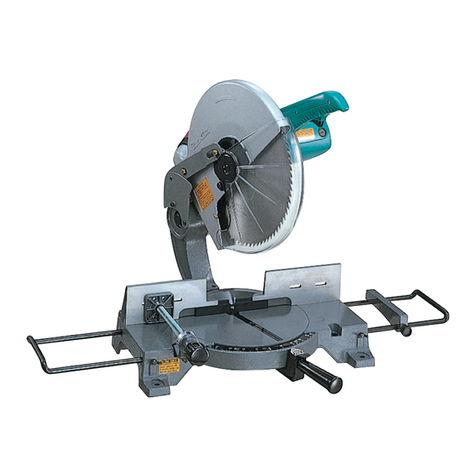
Makita
Makita LS1440 User manual

Makita
Makita DJR183 User manual

Makita
Makita HS6601 User manual
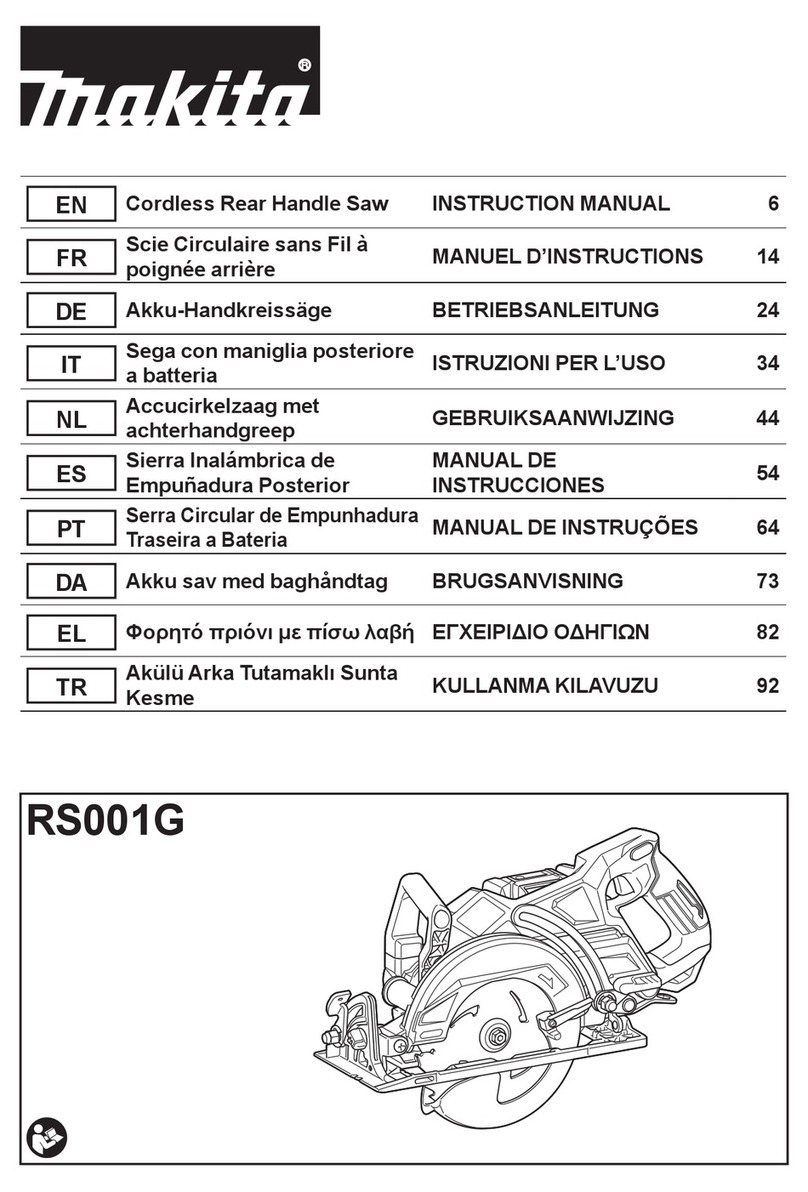
Makita
Makita RS001G User manual
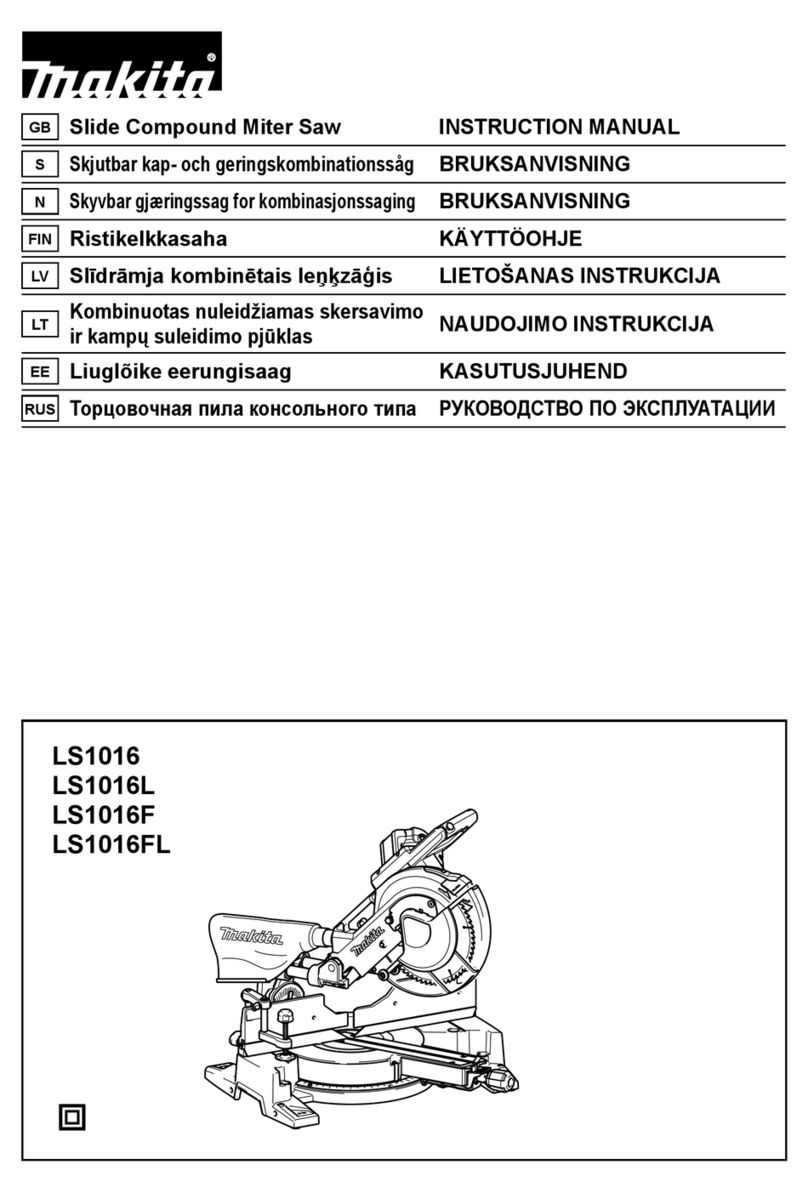
Makita
Makita LS1016 User manual
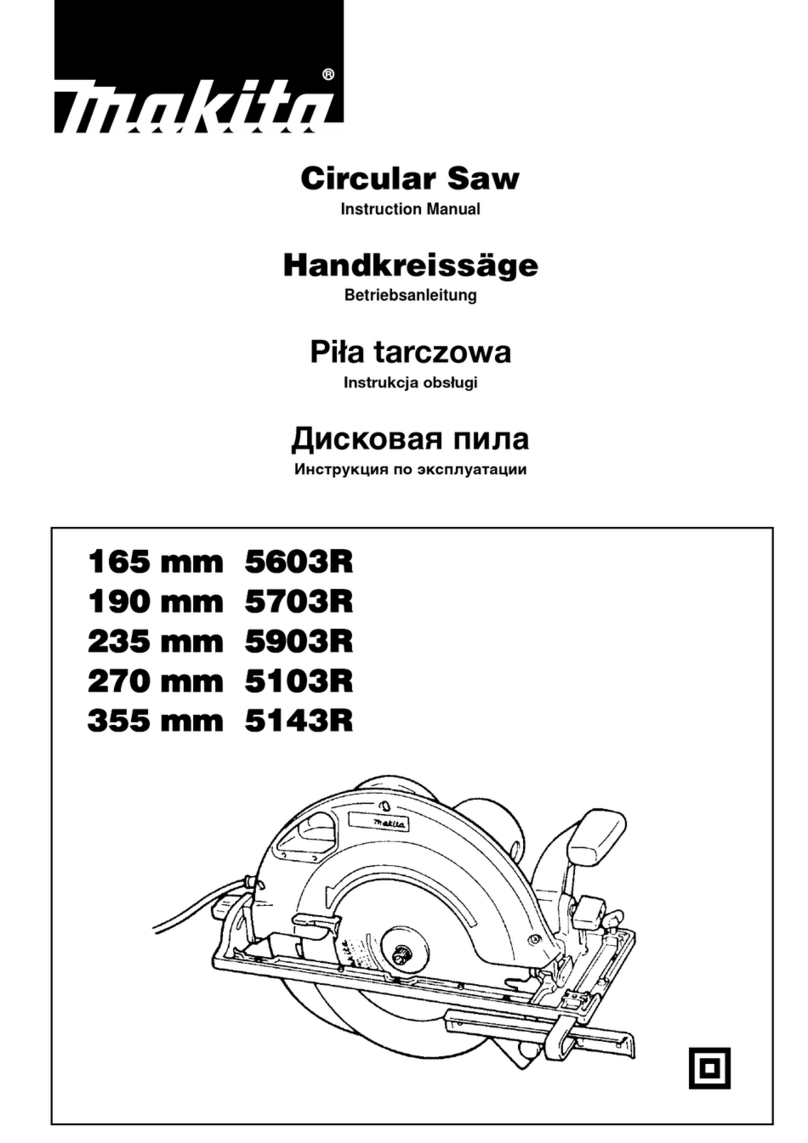
Makita
Makita 5603R User manual
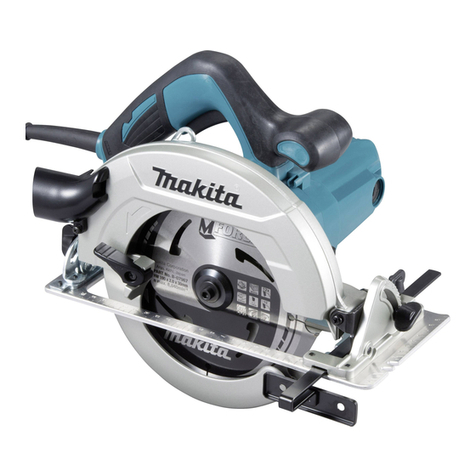
Makita
Makita HS7611 User manual
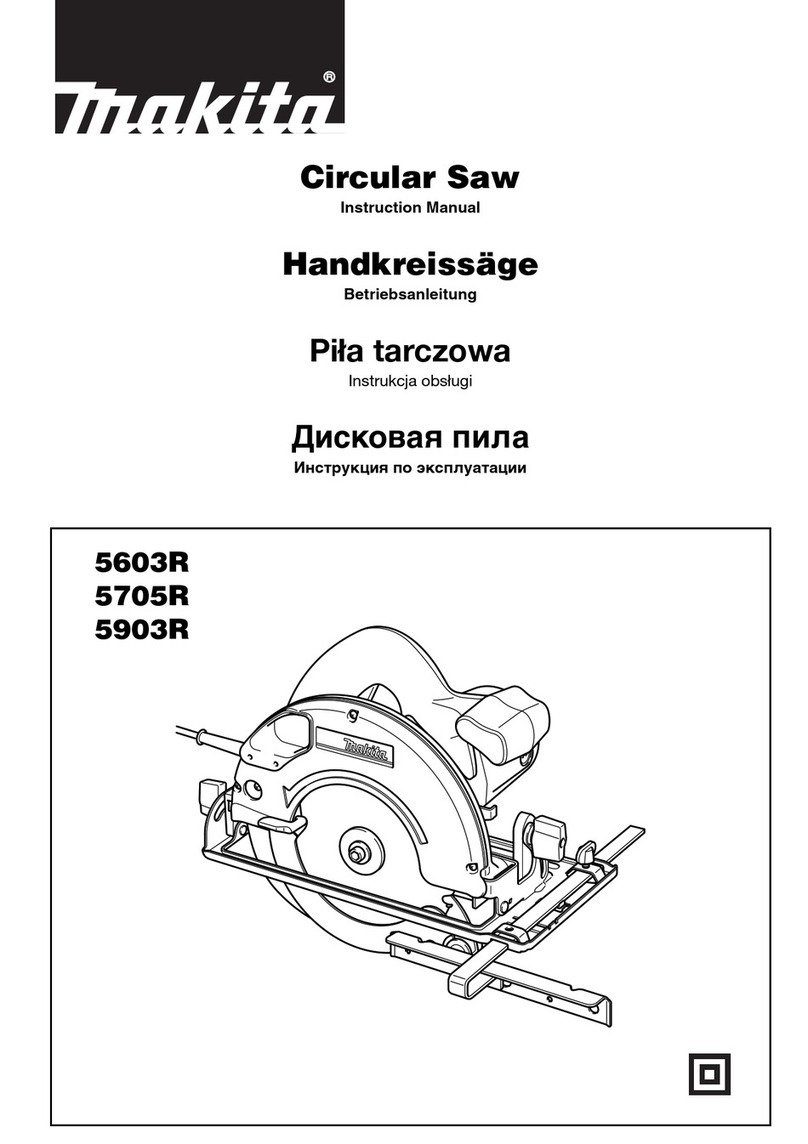
Makita
Makita 5603R User manual

Makita
Makita 2107F User manual
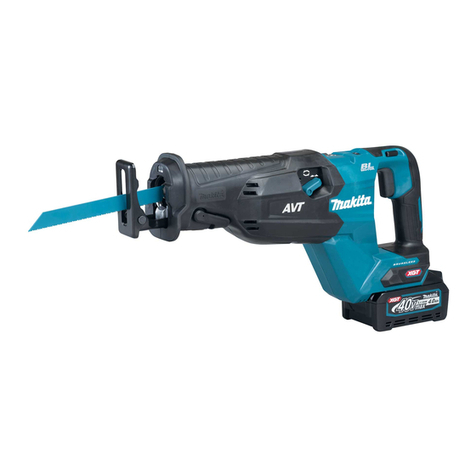
Makita
Makita JR002G User manual
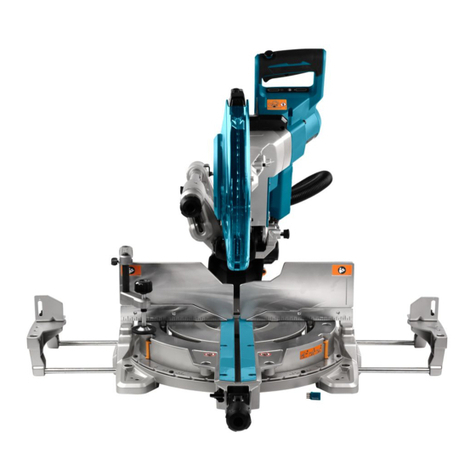
Makita
Makita LS003GZ01 User manual
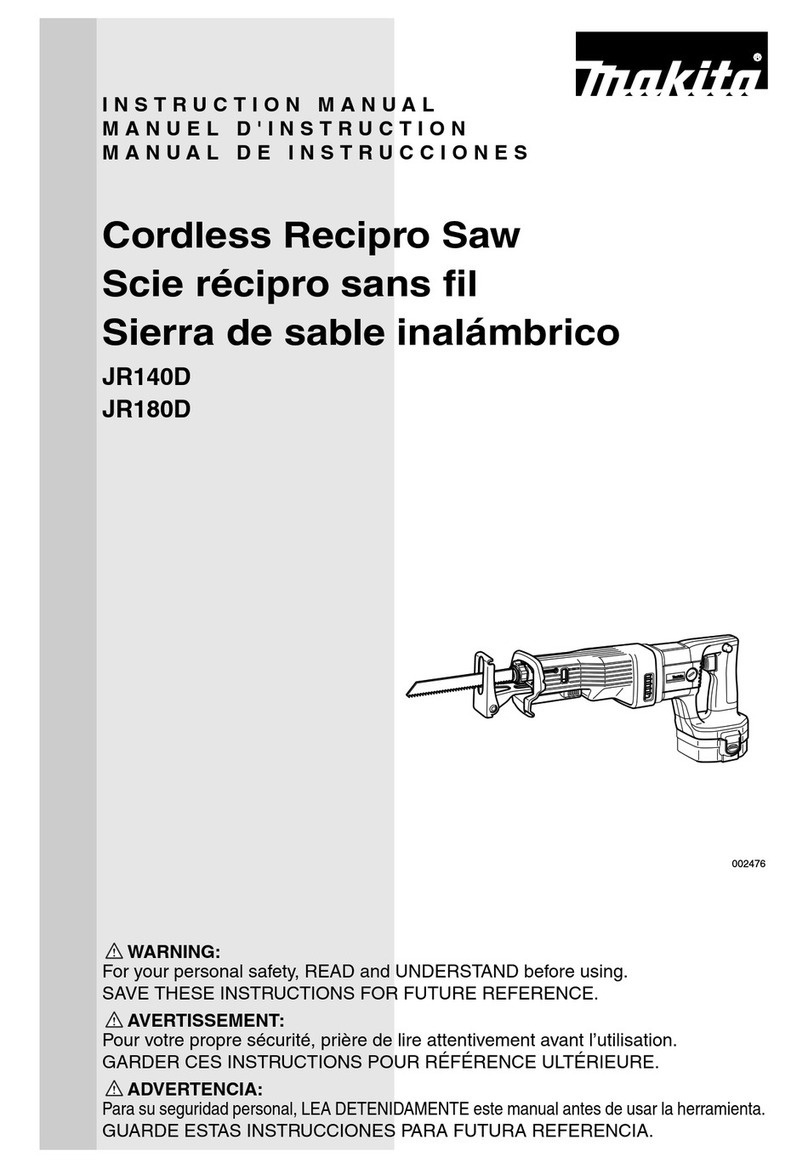
Makita
Makita JR140D User manual
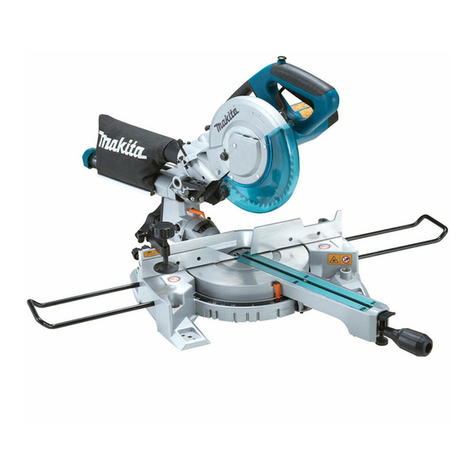
Makita
Makita LS0815F User manual

Makita
Makita XT506S User manual
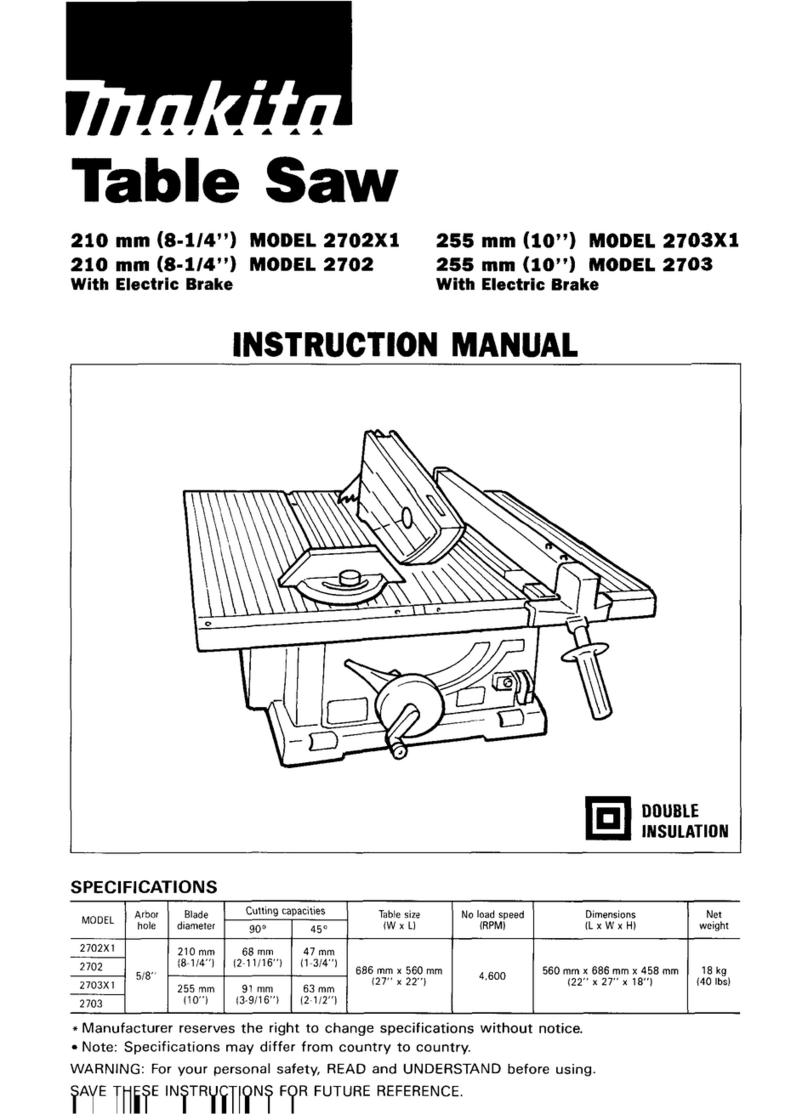
Makita
Makita 2702X1 User manual
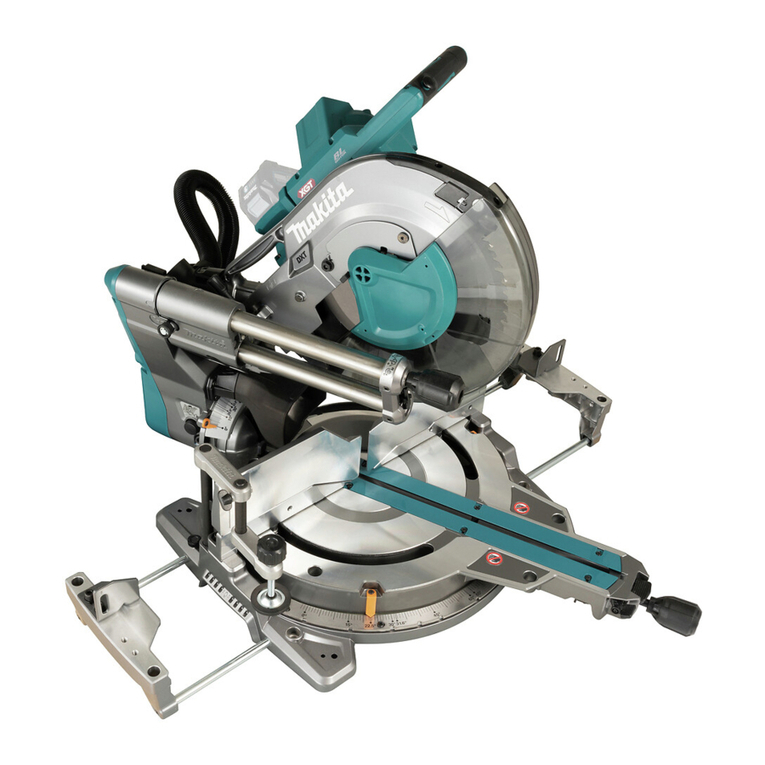
Makita
Makita LS003G User manual
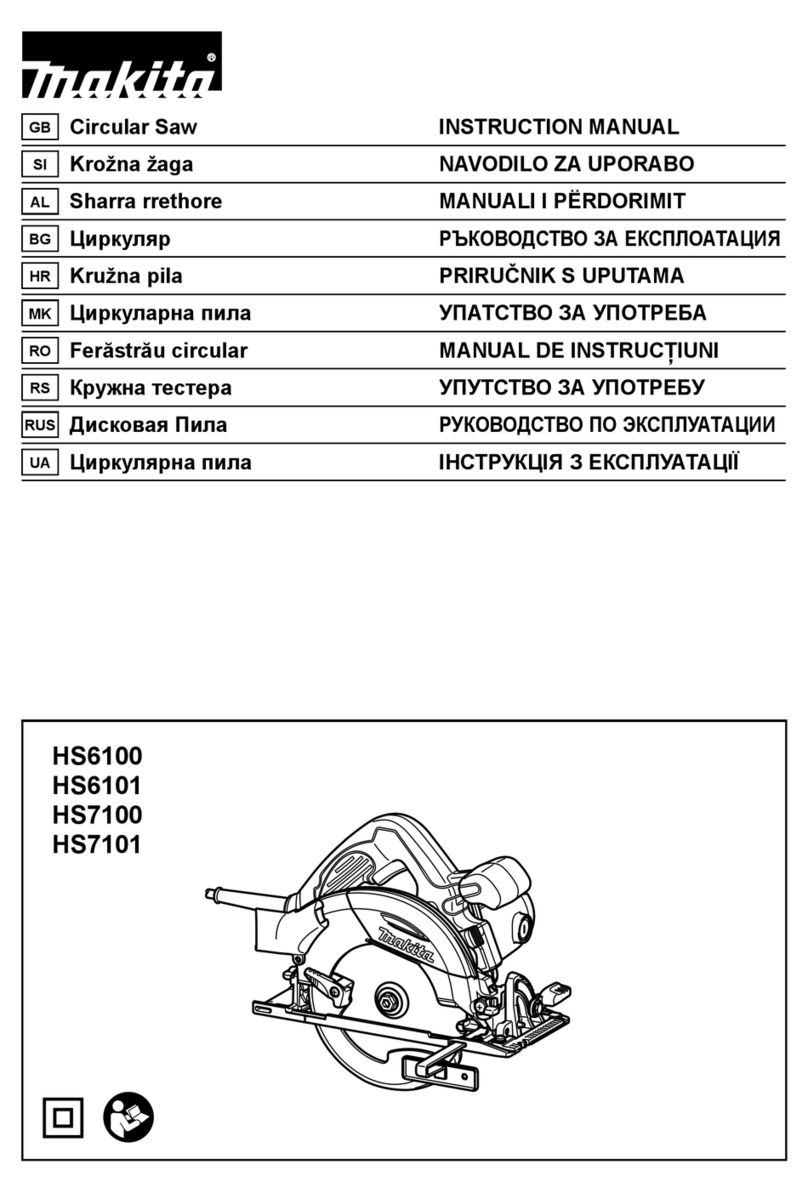
Makita
Makita HS6101 User manual
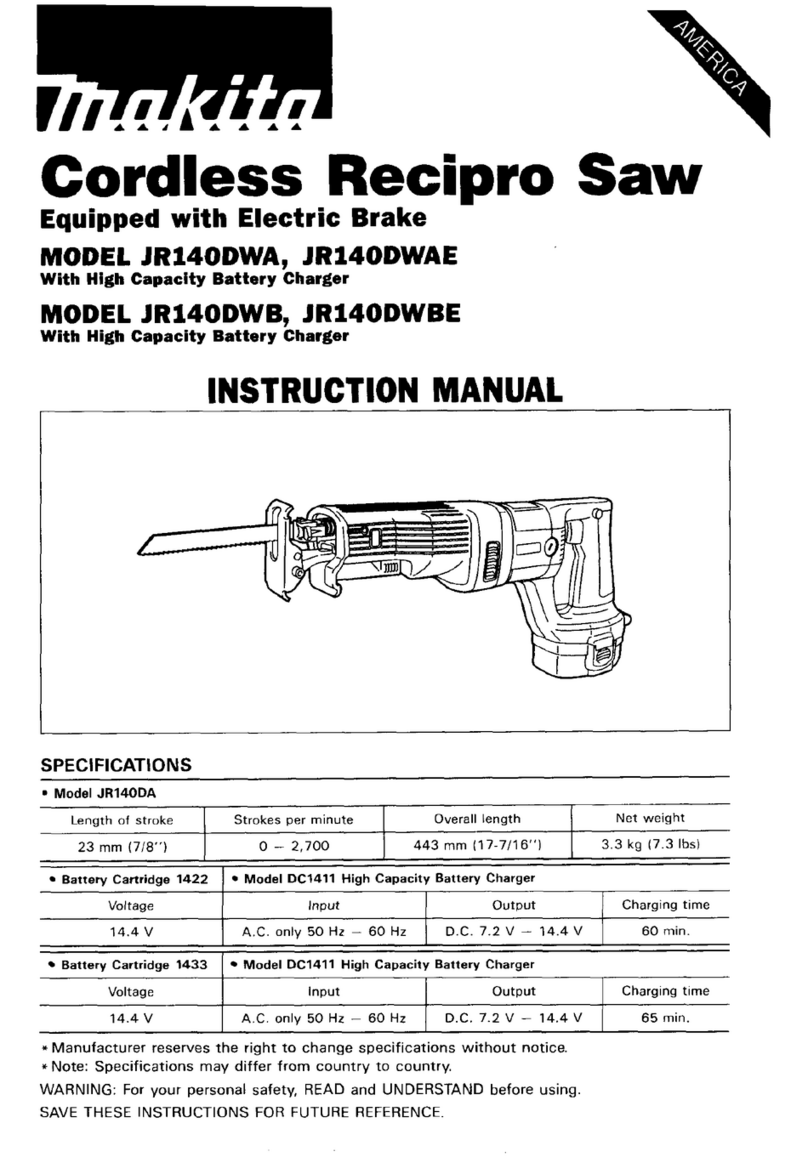
Makita
Makita JRl40DWA User manual
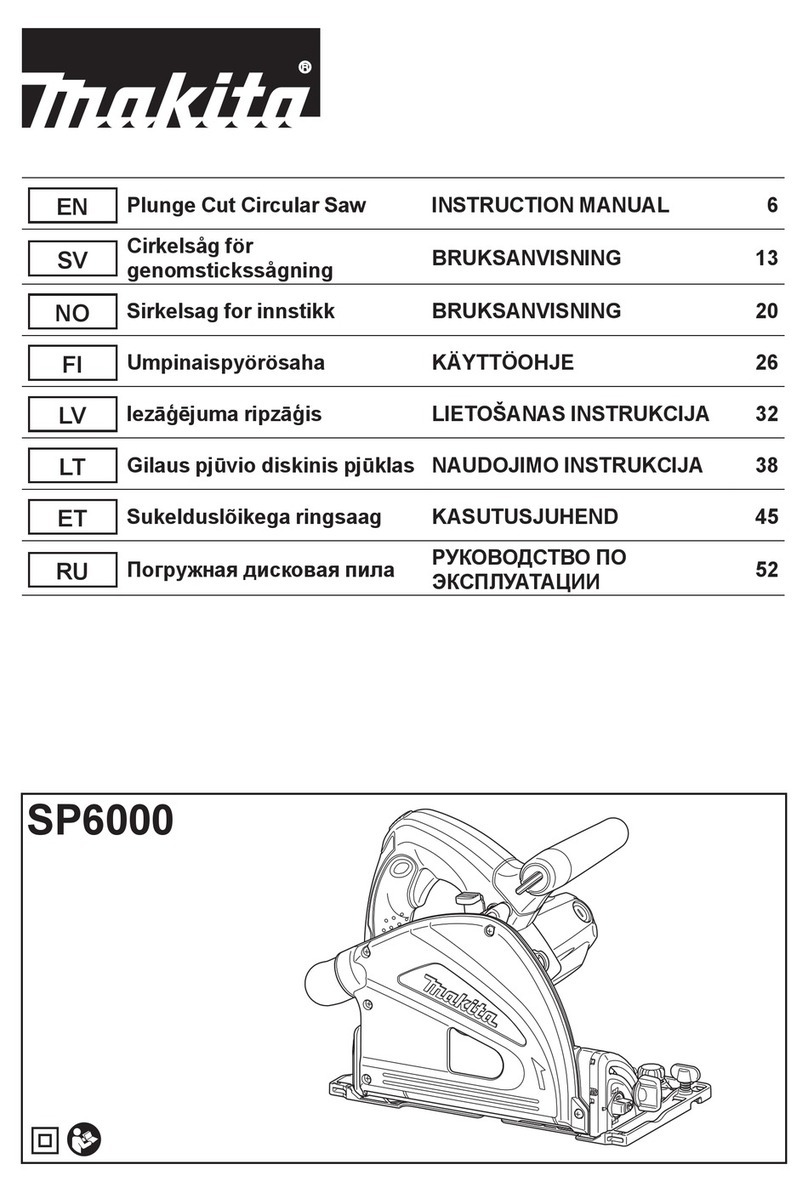
Makita
Makita SP6000 User manual
